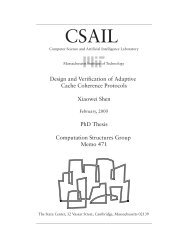Proof of Freshness - Computation Structures Group - MIT
Proof of Freshness - Computation Structures Group - MIT
Proof of Freshness - Computation Structures Group - MIT
You also want an ePaper? Increase the reach of your titles
YUMPU automatically turns print PDFs into web optimized ePapers that Google loves.
where #T [t] indicates the number <strong>of</strong> nodes in T [t]. We delete the nodes in T ′ which correspond to clients in I<br />
(these are the clients who reserve time value tc) and we insert the nodes <strong>of</strong> T [tc − k] which correspond to clients<br />
for which no node in each <strong>of</strong> the k trees T [tc], T [tc − 1], . . ., T [tc − (k − 1)] exists (the size <strong>of</strong> the pro<strong>of</strong>s <strong>of</strong><br />
freshness for these clients gets too large).<br />
A reservation certificate on i is as in the log-based scheme with an additional pro<strong>of</strong> that no node in T ′<br />
corresponds to i. A pro<strong>of</strong> <strong>of</strong> freshness is as in the log-based scheme where the log is truncated up to the first k<br />
sequences. If the log is truncated, then a pro<strong>of</strong> <strong>of</strong> freshness <strong>of</strong> the tree-based scheme based on T ′ is included.<br />
From the definition <strong>of</strong> k in (13), we conclude that a pro<strong>of</strong> <strong>of</strong> freshness contains at most K atomic pieces <strong>of</strong> data.<br />
Performance We use the hybrid scheme together with time-multiplexing with period q. Due to the law <strong>of</strong> large<br />
numbers, inequality (13) is approximately equivalent to<br />
log(N/q) + k log I ≤ K (14)<br />
Let W be the expected size <strong>of</strong> a tree T ′ at any moment. The probability that no device <strong>of</strong> a given client<br />
requests a reservation for at least k + 1 consecutive scheduled time values is equal to (1 − u) T(k+1) . Hence,<br />
W = N<br />
q (1 − u)T(k+1) . (15)<br />
If W is a small constant, then the performance <strong>of</strong> the hybrid scheme is dominated by the log-based part <strong>of</strong> the<br />
scheme. Up to a small constant this will lead to the bound (12) on the total number <strong>of</strong> clients N. The expected<br />
size W is small if and only if<br />
k ≈ 1 N<br />
log<br />
uT q .<br />
Notice that N/q = γ ln 2/β and 1/(uT) ≈ LI in the log based scheme. So, W is small if and only if<br />
See (14), a pro<strong>of</strong> <strong>of</strong> freshness will contain at most<br />
k ≈ LI log(γ/β).<br />
log(N/q) + K ≥ k log I ≈ (1 + LI log I) log(γ/β)<br />
atomic pieces <strong>of</strong> data. The expected size <strong>of</strong> a pro<strong>of</strong> <strong>of</strong> freshness in the log-based scheme is 1 + LI log I atomic<br />
pieces <strong>of</strong> data. We conclude that the hybrid scheme allows as many clients as in the log-based scheme while<br />
restricting the worst-case size <strong>of</strong> a pro<strong>of</strong> <strong>of</strong> freshness to log(γ/β) times the expected size <strong>of</strong> a pro<strong>of</strong> <strong>of</strong> freshness:<br />
Theorem 4 The hybrid scheme with time-multiplexing can serve about as many clients as in the log-based<br />
scheme with the advantage that the worst-case size <strong>of</strong> a pro<strong>of</strong> <strong>of</strong> freshness is at most log(uγ/uβ) times the<br />
expected size <strong>of</strong> a pro<strong>of</strong> <strong>of</strong> freshness.<br />
References<br />
[1] A. Anagnostopoulos, M. Goodrich, and R. Tamassia. Persistent Authenticated Dictionaries and Their Applications. In 4th International Conference<br />
on Information Security (ISC), 2001.<br />
[2] N. Baric and B. Pfitzmann. Collision-free accumulators and fail-stop signature schemes without trees. In Advanves <strong>of</strong> Cryptology: Proceedings <strong>of</strong><br />
Eurocrypt ’97, pages 480–494, 1997.<br />
[3] D. Bayer, S. Haber, and W. Stornetta. Improving the Efficiency and Reliability <strong>of</strong> Digital Time-Stamping. In Sequences II: Methods in Communication,<br />
Security, and Computer Science, pages 329–334, 1993.<br />
[4] M. Bellare and P. Rogaway. Random oracles are practical: A paradigm for designing efficient protocols. In Proceedings <strong>of</strong> the First Annual<br />
Conference on Computer and Communications Security, 1993.<br />
18
















